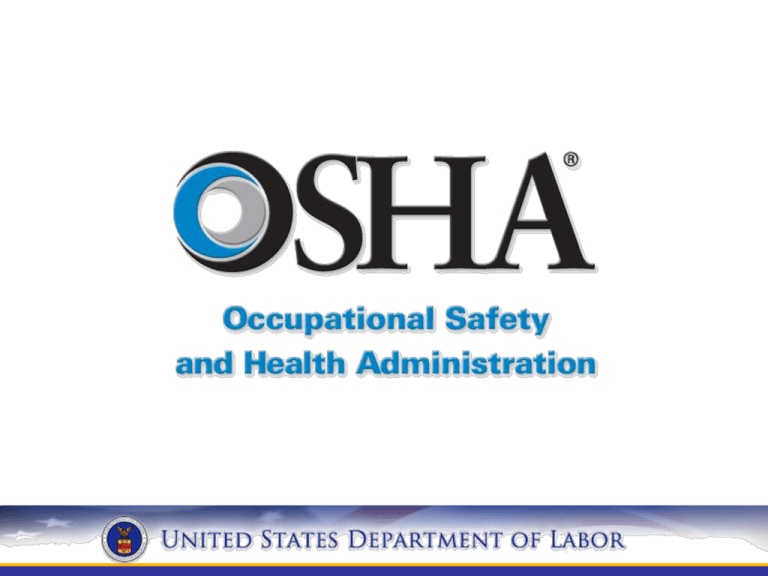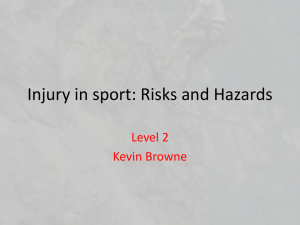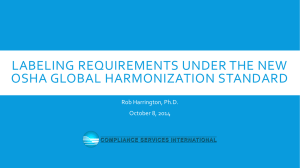Classic Template - White
advertisement

Hazard Communication and the Globally Harmonized System (GHS) David O’Connor Kathy Landkrohn Directorate of Standards and Guidance Overview • Why OSHA adopted the GHS • Overview of the changes to the HazCom Standard • Overview of Compliance Assistance Resources • Directorate of Enforcement Programs Products Why did OSHA align the HCS with GHS? • A common, coherent approach to classifying and communicating chemical hazards – Harmonized definitions of hazards – Specific criteria for labels – Harmonized format for safety data sheets Benefits of Adopting the GHS • Increase the quality and consistency of information provided to the workers, employers and chemical users –Reduce confusion/Increase comprehension of hazards –Improve downstream risk management –Facilitate training –Help address literacy problems • Other benefits include facilitation of international trade in chemicals Development of Final Rule • An ANPR to modify to the existing HCS to align it with the GHS was published in 2006 • NPRM Published in the Federal Register on September 30, 2009 (74 FR 50280-50549) • Public hearings in 2010 • The final rule was published in the Federal Register on March 26, 2012 and became effective on May 25, 2012 Notable changes • Using a “specification” approach rather than a “performance-oriented” approach – “Hazard classification” rather than “hazard determination” • Labels are more defined and will now require: A product identifier, pictogram, signal word, hazard statement (s), precautionary statement(s), name, address and telephone number Notable changes, cont. • “Safety data sheet” (rather than “material safety data sheet”) uses a 16-section format • Guidance in the GHS (such as decision logics in criteria) has been removed to streamline provisions – May be provided as a separate document to assist compliance later Modified Hazard Communication Standard How Hazard Communication Works Organization of the Final Rule • • • • • • • • • • • (a) Purpose (b) Scope and Application (c) Definitions (d) Hazard Classification (e) Written Hazard Communication Program (f) Labels and Other Forms of Warning (g) Safety Data Sheets (h) Employee Information and Training (i) Trade Secrets (j) Effective Dates Appendices A -F Appendices • Appendix A, Health Hazard Criteria (Mandatory) (NEW) • Appendix B, Physical Hazard Criteria (Mandatory) (NEW) • Appendix C, Allocation of Label Elements (Mandatory) (NEW) • Appendix D, Safety Data Sheets (Mandatory) (NEW) • Appendix E, Definition of “Trade Secret” (Mandatory) • Appendix F, Guidance for Hazard Classifications re: Carcinogenicity (Non-Mandatory) (NEW) a) Purpose HazCom 1994 • All hazards to be evaluated • Comprehensive hazard communication program to transmit information • Preempt state laws HazCom 2012 • All hazards to be classified • Other provisions the same, except OSHA added that the rule is consistent with Revision 3 of the GHS • Slight clarifying modification was made to the language regarding preemption b) Scope and Application HazCom 1994 • All chemicals known to be present are covered • Practical accommodations for special situations • Addresses interface with other Federal laws HazCom 2012 • Minimal changes except to conform terminology, and remove reference to current Appendix E which has been deleted from the standard and a clarification on Federalism c) Definitions HazCom 1994 • Includes specific definitions for terms used in the standard, as well as all physical hazards HazCom 2012 Physical hazard definitions removed from paragraph (c), and placed in a new Appendix B on physical hazard classification criteria Following terms are also deleted: flashpoint (methods included in Appendix B), hazard warning, material safety data sheets Some definitions are revised to be GHS-consistent, New definitions added for classification d) Hazard Classification HazCom 1994 HazCom 2012 • Performance-oriented • Specific and detailed – Definitions in paragraph (c), Appendices A and B – Appendix B—parameters for evaluating data – “Floor” of chemicals considered hazardous – “One study” rule – Standardized mixture cut-off rules – Concept of “classification” vs. determination in current rule – Each hazard class has detailed criteria to apply to data on the chemical – No floor; based on weight of evidence – Mixture rules are specific to each hazard class Hazard Classification • Each physical or health hazard is a “hazard class” (e.g., Carcinogenicity is a hazard class) • A “hazard class” may be sub-divided in the criteria into several “hazard categories” based on the degree of severity of the hazard • Placing a chemical into a “hazard class” , and where necessary, a “hazard category”, is the concept of classification—determining not only the hazard, but also the severity of the effect Hazard Classification • Manufacturers are still responsible for determining the hazards of the chemicals they produce or import • Classification (similar to hazard determination) is based on the full range of available information. The procedures for determining if the manufacturer has properly performed the hazard classification are provided in Appendix A (health) and Appendix B (physical) Health Hazards Hazard Class Acute Toxicity Hazard Category 1 2 3 4 1A 1B 1C 2 Serious Eye Damage/ Eye Irritation 1 2A 2B Respiratory or Skin Sensitization 1 Skin Corrosion/Irritation Germ Cell Mutagenicity 1A 1B 2 Carcinogenicity 1A 1B 2 Reproductive Toxicity 1A 1B 2 STOT – Single Exposure 1 2 STOT – Repeated Exposure 1 2 Aspiration 1 Simple Asphyxiants Lactation 3 Single Category 19 Physical Hazards Hazard Class Explosives Flammable Gases Flammable Aerosols Oxidizing Gases Gases under Pressure Hazard Category Unstable Explosives Div 1.1 1 1 1 1 2 2 Div 1.2 Div 1.3 Div 1.4 Div 1.5 Div 1.6 3 4 Type C Type D Type E Type F Type G Type D Type E Type F Type G Compressed Gases Liquefied Gases Refrigerated Liquefied Gases Dissolved Gases Flammable Liquids Flammable Solids Self-Reactive Chemicals Pyrophoric Liquids Pyrophoric Solid Pyrophoric Gases Self-heating Chemicals Chemicals, which in contact with water, emit flammable gases Oxidizing Liquids Oxidizing Solids Organic Peroxides Corrosive to Metals Combustible Dusts 1 1 Type A 1 1 Single category 1 1 2 2 Type B 1 1 Type A 1 Single Category 2 2 Type B 2 2 3 3 3 Type C Hazards not Otherwise Classified • This definition was added to ensure that hazards currently covered by HCS continue to be covered • Information will be required on the safety data sheets in Section 2 • Hazard information on the label, is not mandatory, but can be provided under supplementary information • Such hazards must also be addressed in worker training Simple Asphyxiant and Pyrophoric Gas • “Simple asphyxiant” means a substance or mixture that displaces oxygen in the ambient atmosphere, and can thus cause oxygen deprivation in those who are exposed, leading to unconsciousness and death. – Label: Warning. May displace oxygen and cause rapid suffocation. • “Pyrophoric gas” means a chemical in a gaseous state that will ignite spontaneously in air at a temperature of 130 degrees F (54.4 degrees C) or below. – Label: Danger. Catches fire spontaneously if exposed to air. Combustible Dust • Combustible dust is covered separately from HNOC, but is not specifically defined • Guidance for defining combustible dust is to be taken from existing documents, including the directive for the National Emphasis Program; the NFPA standards also provide useful information • Combustible dust must be addressed on labels where appropriate: – Warning. May form combustible dust concentrations in air. – Paragraph (f)(4) may apply to materials shipped in solid form, that create combustible dust when processed f) Labels and Other Forms of Warning HazCom 1994 • Shipped containers to be labeled with identity, appropriate hazard warnings, and responsible party • Performance-oriented, specifics left to discretion of chemical manufacturer or importer HazCom 2012 Shipped containers to be labeled with product identifier; signal word; hazard statement(s); pictograms; precautionary statements; and responsible party Specifies information by hazard class and category Approach to Labels • The final rule—like the GHS—is a specification approach to labels. In Appendix C, OSHA has indicated by hazard class and hazard category the label elements that must be on the label • Appendix C is basically a cookbook approach to labeling—once classification of the hazards is completed, Appendix C is to be consulted to determine how to convey the required information Label Requirements - Shipped Containers • • • • • • Product identifier Signal word Hazard statement(s) Pictogram(s) Precautionary statement(s) Name, address, and phone number of the responsible party Label Example g) Safety Data Sheets HazCom 1994 • Specifies what information is required, but chemical manufacturer or importer can use whatever format or order of information they want HazCom 2012 • Mandates 16-section SDS headings, order of information, and what information is to be provided under the headings • Will not enforce sections 1215 that require information outside OSHA’s jurisdiction 16-Section Safety Data Sheet 1.Identification of the substance or mixture and of the supplier 2.Hazards identification 3.Composition/information on ingredients Substance/Mixture 4.First aid measures 5.Firefighting measures 6.Accidental release measures 7.Handling and storage 8.Exposure controls/personal protection. 9.Physical and chemical properties 10.Stability and reactivity 11.Toxicological 12.Ecological information (non mandatory) 13.Disposal considerations (non mandatory) 14.Transport information (non mandatory) 15.Regulatory information (non mandatory) 16.Other information including information on preparation and revision of the SDS Appendix D • Specifies the minimum information to be included in each of the 16 sections. • Two revisions in this information are in the final rule: – ACGIH TLVs continue to be required on the SDS – Information regarding carcinogenicity classifications by IARC and NTP also continue to be required h) Employee Information and Training HazCom 1994 HazCom 2012 • Requires employee information and training before a worker is exposed to the hazardous chemicals in the workplace, and whenever the hazard changes • Clarifies that the labels on shipped containers and workplace labels must be explained, as well as SDS format • Workers will have to be trained on the new label and SDS formats before all the provisions of the rule are effective i) Trade Secrets HazCom 1994 HazCom 2012 • Allows specific chemical identity to be protected when it is a legitimate trade secrete. • Specifies conditions for protection, and for release when there is a safety and health need for the information • Process remains the same • Percentage of a substance in a mixture is also considered to be a type of trade secret subject to the provisions in the rule. j) Effective Dates – HazCom 2012 Effective Completion Date Requirement(s) December 1, 2013 June 1, 2015* December 1, 2015 June 1, 2016 Transition Period Train employees on the new label elements and SDS format. Comply with all modified provisions of this final rule, except: Who Employers Chemical manufacturers, importers, Distributors may ship products labeled distributors and by manufacturers under the old system employers until December 1, 2015. Update alternative workplace labeling and hazard communication program as necessary, and provide additional Employers employee training for newly identified physical or health hazards. All chemical Comply with either 29 CFR 1910.1200 manufacturers, (this final standard), or the current importers, distributors and standard, or both. employers *This date coincides with the European Union implementation date for classification of mixtures. The Workplace • For Employers – Initial employee training on the label elements – Minimal training on new SDS format – Continue to maintain the updated SDSs – Review current hazard communication program and update as necessary • For manufacturers – Initial start-up costs associated with reclassification, producing new labels, safety data sheets, training. Other Affected Standards Approach to Other Standards • Many other OSHA standards contain criteria related to defining hazards, as well as other provisions that rely on those criteria • OSHA undertook a comprehensive review of its rules to identify what needed to be changed • OSHA has proposed modifications to all of those standards that it determined needed to be consistent with the GHS Health Standards • The substance-specific standards generally pre-date the HCS, and do not have a comprehensive approach to hazard communication • The final rule references the HCS 2012 in each of these standards to ensure they have all the protections of the rule • In addition, OSHA updated the provisions regarding what is to be communicated to workers to ensure the health effects are consistent with the GHS criteria • Regulated area signs will need to be updated to reflect the new language. • Employers have until June 1, 2016 to update the signs Substance-Specific Health Standards Standard Substance Original signs 1910.1001 1915.1001 DANGER DANGER Asbestos ASBESTOS ASBESTOS Regulated areas CANCER AND LUNG MAY CAUSE CANCER Where the use of DISEASE HAZARD CAUSES DAMAGE TO respirators and AUTHORIZED LUNGS protected PERSONNEL ONLY AUTHORIZED PERSONNEL clothing is RESPIRATORS AND ONLY required PROTECTIVE CLOTHING WEAR RESPIRATORY ARE REQUIRED IN THIS AREA Final Changes PROTECTION AND PROTECTIVE CLOTHING IN THIS AREA Health Standards Asbestos (1910.1001; 1926.1101; 1915.1001) 13 Carcinogens (1910.1003) Vinyl Chloride (1910.1017) Inorganic Arsenic (1910.1018) Lead (1910.1025; 1926.62) Chromium (VI) (1910.1026; 1926.1126; 1915.1026) Cadmium (1910.1027; 1926.1127) Benzene (1910.1028) Coke Oven Emissions (1910.1029) Cotton Dust (1910.1043) 1,2-dibromo-3-chloropropane (1910.1044) Acrylonitrile (1910.1045) Ethylene Oxide (1910.1047) Formaldehyde (1910.1048) Methylenedianiline (1910.1050; 1926.60) 1,3-Butadiene (1910.1051) Methylene Chloride (1910.1052) Occupational exposure to hazardous chemicals in laboratories (1910.1450) Safety Standards • OSHA updated a number of safety standards to be consistent with the criteria in the HCS 2012 • The manner in which this was done depended on the provisions of the standard being considered, and approaches varied • In some cases, it was decided that changes could not be made at this time given the source of the standard or other constraints • OSHA sought to minimize the impact on the scope or substantive provisions of the standards that were updated Safety Standards PSM 1910.119(a)(1)(ii) • HCS 1994 A process which involves a flammable liquid or gas (as defined in 1910.1200(c) of this part) on site in one location, in a quantity of 10,000 pounds (4535.9 kg) or more except for: • HCS 2012 A process which involves a Category 1 flammable gas (as defined in 1910.1200 (c)) or a flammable liquid with a flashpoint below 100 °F (37.8 °C) on site in one location, in a quantity of 10,000 pounds (4535.9 kg) or more except for: Safety Standards Flammable Liquids (1910.106; 1926.52) Spray finishing using flammable and combustible materials (1910.107) Process safety management of highly hazardous chemicals (1910.119; 1926.64) Hazardous waste operations and emergency response (1910.120; 1926. 65) Dipping and coating operations: Coverage and definitions (1910.123; ) General requirements for dipping and coating operations (1910.124) Additional requirements for dipping and coating operations that use flammable liquids or liquids with flashpoints greater than 199.4 oF (93 oC). (1910.125) Welding, Cutting, and Brazing (1910.252) Guidance & Outreach Updated HazCom Webpage Guidance & Outreach Highlights: • • • • HCS / GHS Final Rule – Federal Register: The Final Rule was filed on March 20th at the Office of the Federal Register and available for viewing on their Public Electronic Inspection Desk. The Federal Register published the final rule on March 26, 2012. The effective date of the final rule is 60 days after the date of publication. • Federal Register [PDF, 52 MB] Comparison of Existing and Revised HCS – Side-by-side – Redline Strikeout of the Regulatory Text Press Release: US Department of Labor's OSHA publishes final rule to update the Hazard Communication Standard (HCS) Guidance – OSHA Briefs [PDF 263 KB] – Fact Sheet – Quick Cards Guidance & Outreach Guidance & Outreach • Hazard Communication • HCS / GHS Final Rule & Appendices • Hazard Communication GHS Final Rule [PDF 2.33 MB] • Hazard Communication/GHS Regulatory Text • Appendix A [PDF 422 KB] • Appendix B [PDF 170 KB] • Appendix C [PDF 570 KB] • Appendix D [PDF 91 KB] • Appendix F [PDF 150 KB] • Comparison of Existing and Revised HCS • Side-by-side • Redline Strikeout of the Regulatory Text Guidance & Outreach Guidance & Outreach OSHA is developing an array of guidance materials: Initial Materials: •Quick cards, OSHA briefs, booklets, small entity compliance guides Technical Materials •Model training materials; Safety Data Preparation guidance; Hazard Classification Guidance Web Applications Web Applications • SDS Electronic Form • Label Elements Application • Acute Toxicity Calculator Updated Webpages HCS 2012 Webpage: http://www.osha.gov/dsg/hazcom/index.html Safety & Health Topics Webpage: http://www.osha.gov/dsg/hazcom/index2.html UN GHS Links & Information • • United Nations Economic Commission for Europe GHS Subcommittee Directorate of Enforcement Programs: Products • Letters of Interpretation – Provide guidance on specific sections of the standard. – Where appropriate, will be incorporated into the directive. • Hazard Communication Directive – Provides guidance on how OSHA enforces the Hazard Communication Standard. Hazard Communication Directive • Provides an outline to compliance officers of what to review and how to cite violations of either HCS 1994 or HCS 2012. • Covers sections of the standard and provides clarification on how the individual subparts should be reviewed and enforced. Questions?






